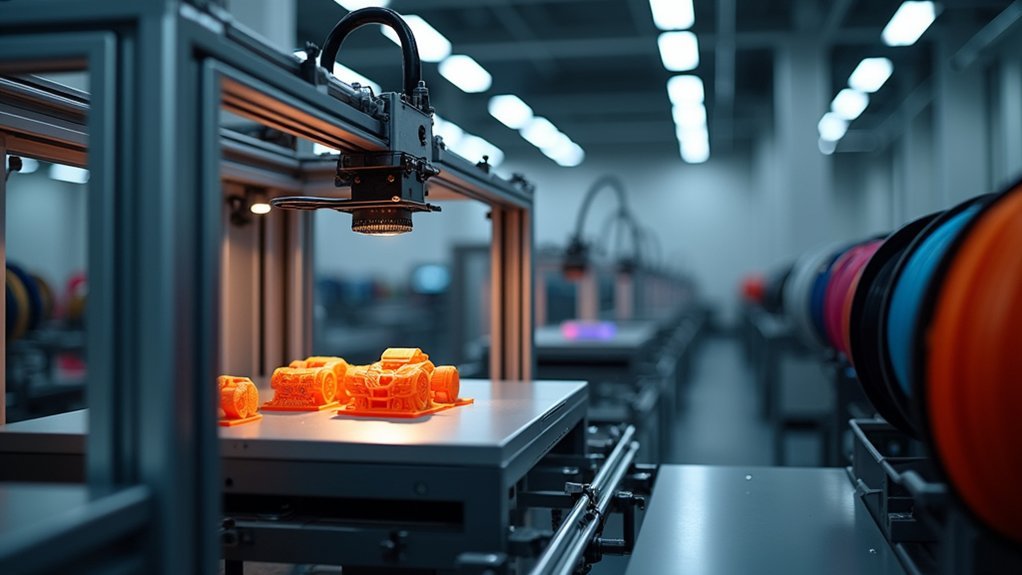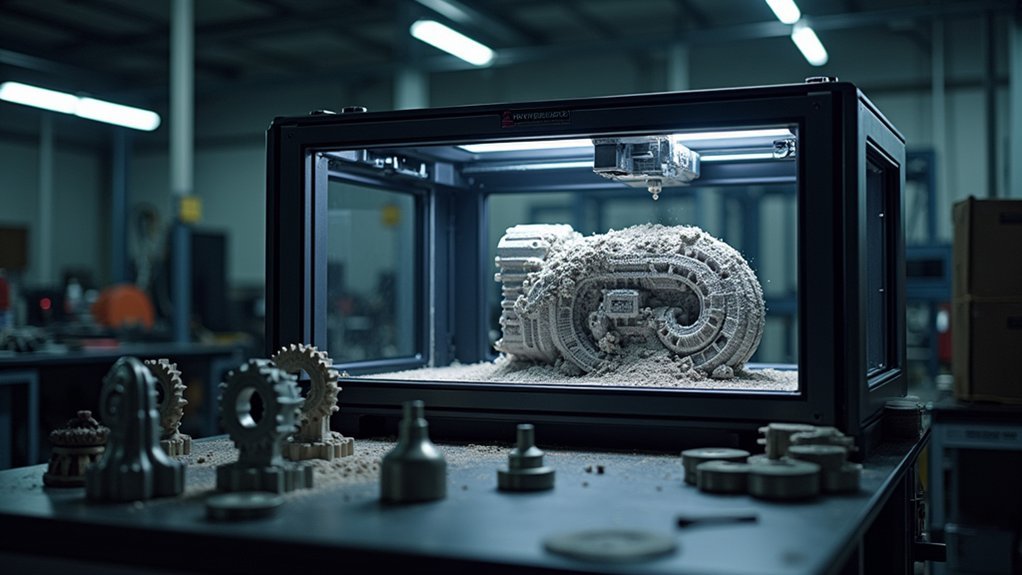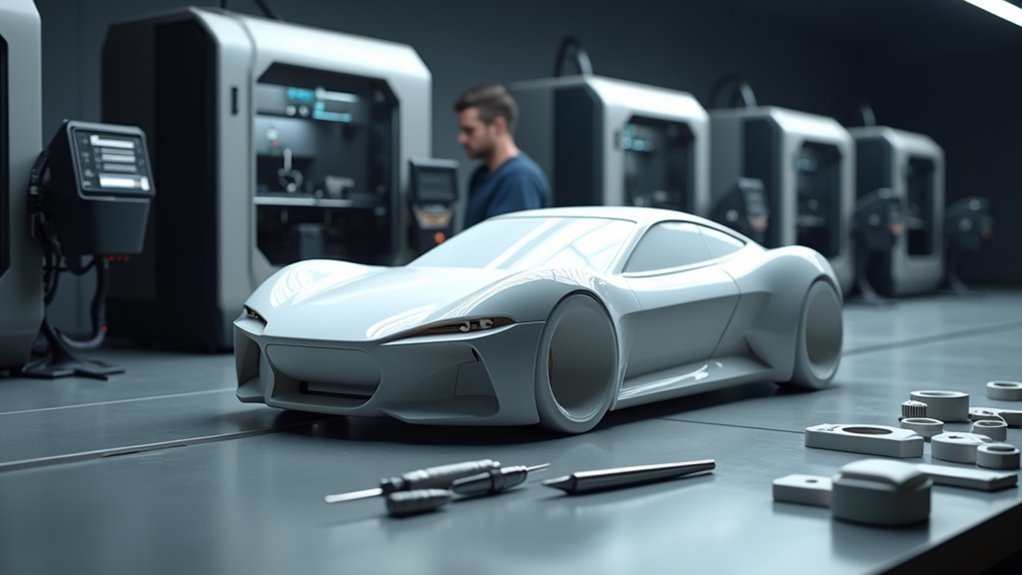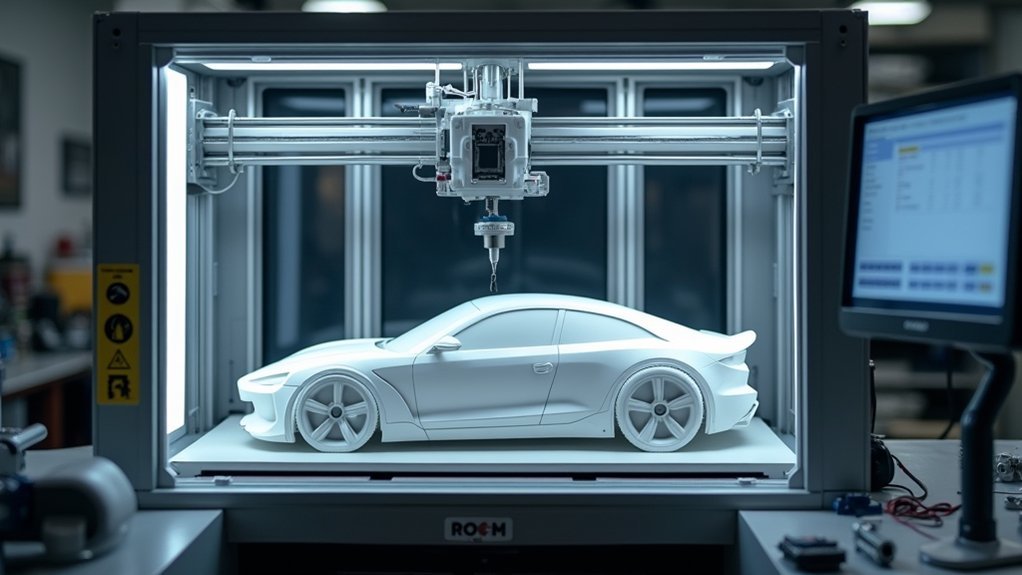You’ll find that industrial 3D printers like FDM systems with 12 x 8 x 12 inch build volumes, SLS technology using high-powered lasers, and metal additive manufacturing systems greatly accelerate automotive prototyping by producing functional parts in hours rather than weeks. These printers support over 30 materials, create complex geometries in single runs, and deliver exceptional mechanical properties for engine components, interior parts, and tooling that meet stringent automotive standards while reducing development costs and lead times considerably.
Key Features That Make Industrial 3D Printers Ideal for Automotive Applications

While traditional manufacturing methods can take weeks or months to produce automotive prototypes, industrial 3D printers deliver the speed and precision you need to accelerate your development timeline.
Industrial 3D printing offers exceptional design freedom with large build envelopes accommodating automotive parts up to 12 x 8 x 12 inches. You’ll benefit from patented jam-resistant hot end technology that works with over 30 materials, ensuring versatility for diverse automotive applications.
Interchangeable nozzles with 0.35 and 0.50 orifices let you optimize for speed or detail depending on your project requirements. The sensible pricing makes rapid prototyping cost-effective, while multiple printer capability eliminates bottlenecks, dramatically reducing wait times in your development process.
Fused Deposition Modeling (FDM) Printers for Large-Scale Automotive Components
When you’re developing large automotive components, FDM printers offer the build volume capacity you need, with some models supporting parts up to 12 x 8 x 12 inches.
You’ll gain access to over 30 different materials through advanced jam-resistant hot ends, giving you the versatility to match specific automotive requirements.
This combination of size capability and material options creates cost-effective production solutions that streamline your prototyping process from initial concept to final testing.
Large Build Volume Capabilities
Automotive prototyping demands substantial build volumes that can accommodate everything from dashboard components to engine housings in a single print run.
FDM printers like Airwolf’s models offer impressive large build volumes up to 12 x 8 x 12 inches, enabling you to create substantial automotive components without size constraints. You’ll eliminate multiple assembly processes since these expansive capabilities allow complete prototyping of complex geometries in single builds.
This streamlined approach accelerates your automotive design iterations remarkably. You can rapidly produce functional prototypes that closely mirror final product performance and aesthetics, testing designs without traditional manufacturing delays.
The ability to print large-scale parts means you’re achieving dramatic time savings throughout development cycles. Your engineering teams can focus on innovation rather than worrying about size limitations or assembly complications.
Multi-Material Printing Versatility
Beyond size advantages, FDM printers deliver exceptional material versatility that transforms automotive prototyping possibilities.
You’ll access over 30 different materials through patented jam-resistant hot ends, enabling multi-material printing for diverse automotive applications. This versatility lets you create rigid structural components and flexible parts within the same design workflow.
You can shift seamlessly between materials for functional prototyping without changing equipment or processes.
Whether you’re developing dashboard components requiring specific textures or engineering brackets demanding high strength-to-weight ratios, you’ll find suitable materials.
Interchangeable nozzles with 0.35 and 0.50 mm orifices let you balance speed with detail based on your design requirements.
This material flexibility accelerates your development cycles by eliminating the need for multiple specialized machines or outsourced production for different prototype components.
Cost-Effective Production Solutions
While traditional automotive manufacturing demands substantial capital investment in tooling and equipment, FDM printers deliver cost-effective production solutions that’ll transform your prototyping budget.
You’ll eliminate expensive tooling requirements while producing complex geometries directly from digital designs. These systems utilize affordable thermoplastic materials and maintain lower operational costs compared to conventional manufacturing methods.
Your rapid prototyping capabilities will dramatically improve, reducing lead times and enabling quicker design iterations essential for competitive automotive development.
You can produce custom parts efficiently without the financial burden of traditional tooling investments. FDM technology’s ability to create automotive components up to 12 x 8 x 12 inches means you’ll handle large-scale parts while maintaining budget control and accelerating your time-to-market for new designs.
Selective Laser Sintering (SLS) Technology for High-Performance Automotive Parts
When precision meets innovation in automotive prototyping, Selective Laser Sintering (SLS) technology emerges as a game-changing solution that’s revolutionizing how manufacturers create high-performance components.
You’ll find that SLS uses high-powered lasers to fuse powdered materials like nylon and polymers, producing functional parts with exceptional mechanical properties and thermal resistance without requiring support structures.
This technology enables you to create intricate automotive components that are both lightweight and structurally sound.
You can rapidly iterate complex geometries that traditional manufacturing methods can’t achieve, greatly reducing your design cycle times.
The ability to produce durable, high-performance parts quickly means you’ll accelerate your time-to-market while maintaining the quality standards essential for modern automotive engineering applications.
Metal Additive Manufacturing Systems for Engine and Powertrain Components

As automotive engineers push the boundaries of engine performance and efficiency, metal additive manufacturing systems have become essential tools for creating revolutionary powertrain components that weren’t possible with traditional production methods.
You’ll find that selective laser melting (SLM) and direct metal laser sintering (DMLS) technologies excel at producing complex geometries that optimize airflow while dramatically reducing weight.
These systems cut your production time considerably through rapid prototyping capabilities, allowing faster iteration from concept to final part. You can utilize advanced materials like titanium and high-strength steel to create printed car parts that meet stringent durability standards.
Metal additive manufacturing enables rapid prototyping with titanium and high-strength steel, accelerating development cycles while meeting strict automotive durability requirements.
While Selective Laser Sintering (SLS) handles polymers effectively, metal additive manufacturing delivers the robust engine components you need for enhanced vehicle performance and fuel efficiency.
Stereolithography (SLA) Printers for Precision Interior and Exterior Prototypes
Precision becomes paramount when you’re developing automotive interior and exterior prototypes that demand exceptional detail and surface quality.
Stereolithography (SLA) printers deliver the high-resolution capabilities you need for creating intricate automotive designs with fine features. You’ll achieve smooth surface finishes that closely mimic final production parts through SLA’s laser-curing technology, which processes liquid resin layer by layer.
Your prototypes can reach dimensions up to 353 x 196 x 350 mm, accommodating larger automotive components in single prints.
While you’ll need post-processing steps like washing and curing, these enhance mechanical properties essential for high-performance applications.
SLA’s rapid prototyping capabilities let you iterate designs quickly, testing and refining prototypes efficiently to accelerate your development cycle.
Multi-Jet Fusion Technology for Rapid Automotive Tooling and Manufacturing Aids

While traditional tooling methods can take weeks or months to deliver, Multi-Jet Fusion (MJF) technology revolutionizes your automotive tooling and manufacturing aid production by dramatically cutting lead times.
This process applies liquid binding agents to powdered materials before using heat to fuse them, creating parts with exceptional mechanical properties and complex geometries.
You’ll produce durable injection mold inserts and assembly aids that withstand demanding manufacturing conditions.
MJF’s rapid production capabilities enable lightweight component creation, improving efficiency and performance while supporting sustainability goals.
The technology’s flexibility allows on-demand manufacturing, eliminating extensive inventory needs and reducing supply chain waste.
You can now create high-quality automotive tooling quickly and efficiently, transforming your production timelines and operational effectiveness.
Automated Industrial Systems That Streamline Automotive Production Workflows
You’ll find that fully automated metal printing systems revolutionize your automotive production by eliminating manual intervention and enabling continuous operation.
These streamlined workflows integrate automated de-powdering, sieving, and sequential task management to reduce your labor requirements while maintaining consistent output quality.
Your enhanced quality control systems now monitor every stage of production automatically, ensuring you meet automotive industry standards without compromising speed or efficiency.
Fully Automated Metal Printing
As automotive manufacturers face mounting pressure to accelerate production timelines while maintaining stringent quality standards, fully automated metal 3D printing systems have emerged as game-changing solutions that considerably reduce labor requirements and streamline complex workflows.
These systems enable remote job starts and efficient production runs, allowing you to optimize your automotive manufacturing processes without constant manual intervention.
You’ll benefit from modular configurations that adapt to changing production demands while maintaining high uptime and build rates. The technology’s closed-loop powder handling ensures enhanced safety and quality control.
Streamlined Production Workflows
Once automotive manufacturers implement automated industrial 3D printing systems, they’ll discover how streamlined workflows transform their entire production ecosystem through intelligent task sequencing and reduced manual touchpoints.
You’ll find that automated processes like de-powdering and sieving eliminate bottlenecks while reducing labor requirements throughout your manufacturing chain. These industrial systems enable simultaneous execution of up to eight sequential tasks, dramatically improving production efficiency and accelerating lead times.
Your modular configurations adapt seamlessly to changing production demands, ensuring high uptime when you need it most.
The user-friendly interfaces simplify your shift to advanced technologies, making adoption effortless for your teams.
You’ll achieve superior quality control, enhanced speed, and improved safety through these intelligent automated processes that optimize every aspect of your automotive prototyping workflow.
Enhanced Quality Control Systems
Enhanced quality control systems built into automated industrial 3D printing workflows provide real-time monitoring capabilities that detect defects instantaneously during automotive prototyping.
You’ll benefit from integrated sensors that identify variances immediately, eliminating extensive manual inspections and reducing production costs considerably. These automated systems expedite issue identification and correction, delivering short lead times that accelerate your development cycles.
Your enhanced quality control processes guarantee consistent prototype quality through continuous feedback loops and stringent specification adherence.
Advanced data analytics provide actionable insights into production trends and quality metrics, enabling you to make informed decisions for process optimization.
This streamlined approach minimizes waste, reduces the likelihood of design iterations, and enhances overall efficiency in your automotive prototyping operations while maintaining exceptional quality standards.
Frequently Asked Questions
What Is the Best 3D Printer for Prototyping?
You’ll find Airwolf 3D printers excel for prototyping with their large 12x8x12 inch build envelope, jam-resistant hot end supporting 30+ materials, interchangeable nozzles, and affordable pricing that accelerates your development process.
Which Industry Has Utilized 3D Printing for Rapid Prototyping of New Product Designs?
You’ll find the automotive industry has extensively utilized 3D printing for rapid prototyping new designs. Companies like Saleen and Hector Gama have successfully implemented desktop printers for creating innovative car parts.
How Is 3D Printing Used in the Automotive Industry?
You’ll use 3D printing in automotive for rapid prototyping, creating custom parts, testing components, and producing on-demand replacements. You can iterate designs quickly, reduce development costs, and manufacture complex geometries that traditional methods can’t achieve.
Which Printers Are Being Used in Manufacturing Industries to Create Prototypes of Products?
You’ll find Airwolf 3D printers dominating automotive prototyping with their jam-resistant hot ends supporting 30+ materials. You’re also seeing SLS and DMLS metal printers creating lightweight, durable components for high-performance applications.





Leave a Reply